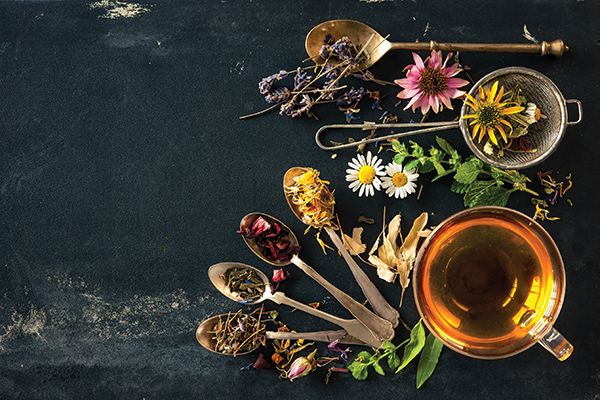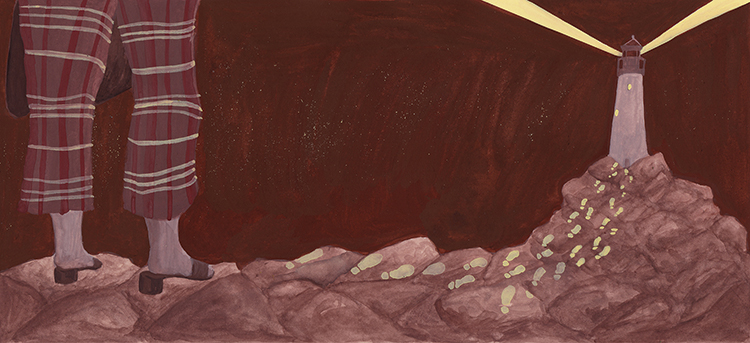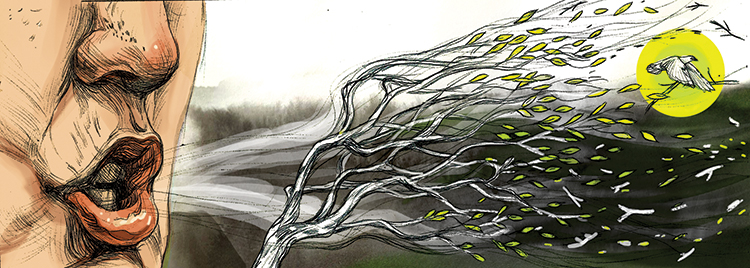Home Brew
by Anna Herman
Herbs, fresh and dried, are an essential ingredient in many a culinary endeavor. Where would we be without pasta with basil pesto, or chive cream cheese on a toasted bagel? Herbs are equally important in hot water—but try not to call it tea.
Black and green tea are both made from the leaves of a shrubby evergreen plant, Camellia sinensis, grown mainly in China, India and Sri Lanka. Hot water infusions of these leaves are the only drinks properly named “tea.” That said, we are all in the habit of calling hot and cold beverages made by infusing (pouring very hot water over) or decocting (simmering) the leaves and flowers of aromatic plants as herbal “teas,” though they are more correctly named tisanes or infusions.
Tisanes, or herbal teas, can be flavorful, medicinal, soothing, energizing and all manner of refreshing—and they are easily made from homegrown or bulk-purchased herbs. A simple handful of fresh mint plunged into a teapot filled with very hot water left to steep for three to four minutes makes a fantastic beverage. You can drink it hot or cold, with or without a bit of honey.
Herbalists often mix a variety of dried leaves, flowers, barks, roots and peels to make a blend pleasing to the eye, nose, palate and spirit. Many common plant parts have traditional medicinal value—mint and ginger are considered digestive aids; chamomile and hops soporifics; thyme and sage are thought to help heal sore throats and coughs, while echinacea and elderberry may offer general immune system support.
You can blend combinations that both taste good and are good for you. Learn as much as you can about any plant you are going to brew and consume. While most commonly known herbs are considered safe for regular use, there are herbs contraindicated if you are pregnant or nursing, others that you could have an allergic reaction to, or those that interact with other medications you are taking.
Tea bags have become a convenient delivery source for all manner of teas, but the quality, quantity and freshness is always somewhat suspect. Why pay for packing, labeling, marketing, sales and distribution when for a fraction of the cost of fancy brands you can blend yourself a high quality herbal concoction for every meal and mood? Get yourself a reusable tea sock strainer or infuser for your teapot or mug.
Where to start? Read the labels on the herb tea blends you’ve purchased. Note the ingredients. Do you like lemony fresh? Try a mix of lemon verbena, lemongrass and lemon balm; floral and fruity might lead you to blend linden, lavender, calendula and rose petals. Stressed or having a hard time sleeping? Try a mix of hops and chamomile. Mix and match what is readily available with what strikes your fancy.
Grow or Buy
The easiest herbs to grow for tea include various mints, chamomile, lavender, calendula, catnip, lemon verbena, lemon balm, thyme and bee balm (also known as Oswego tea). Other herb “tea” components that you could find in your backyard, local store or farmstand include: elderberries, blackberry leaf, red clover, dandelion leaf and root, nettle, oatstraw, hops, fennel seed, lemongrass, lemon peel, fresh or dried ginger and dried fruit.
Most of these and more can be found at the Herbiary in Reading Terminal Market, Weavers Way Co-op in Mount Airy and Chestnut Hill, or online at a variety of sources such as Mountain Rose Herbs. Many local herbalists and purveyors are excellent resources to learn more about the qualities and characteristics of the ingredients you select.
Harvest & Store
If you grow your own herbs, harvest and bundle to dry in a well-ventilated space away from direct light. Most herbs should be harvested early in the day, just after the dew has dried. If harvesting for leaf (e.g., mint, lemon balm, lemon verbena), choose specimens that haven’t flowered. If harvesting flowers (e.g., chamomile, calendula, lavender) clip the flowers when they’re young. Fennel can be harvested in the flower or seed stage. If you’re wild harvesting (e.g., nettles, burdock, plantain, elder flowers or berries), be sure the area is free of pesticides and pollution. Loosely tie most herbs and flowers to dry in a well-ventilated, protected space. A woven basket, screened box or loosely tied paper bag with a few air holes all work.
Once completely dry, the herb leaves can be removed from the stems and should be stored in a well-sealed and labeled tin, bag or glass jar that is kept out of the light.
Use
I am partial to straight-up lemon verbena, which I grow in large quantities, use fresh all summer and fall, and dry for winter and spring, so I have some on hand year-round. All summer I use fresh herbs from the garden, and for fall and winter create a few blends for gifts and family therapy.
The one I serve after big, indulgent dinners includes lemon verbena with a mix of mints and lavender; another for pretest jitters features chamomile, hops, lemon verbena and lavender; our go-to sore throat, cold and cough blend is thyme, mint, sage, lemon balm, echinacea root and flowers and fennel served warm with lots of honey.
For a holiday gift, I jar up a fragrant blend of lemon verbena, lemon grass, red clover flowers, lavender buds, rose petals and dried elderberries. Freshly harvested in early fall, packed in early winter, a cup looks, smells and tastes just a bit like summer.
Anna Herman is a garden educator who raises chickens, ducks, bees, fruits and veggies in her Mount Airy backyard.







